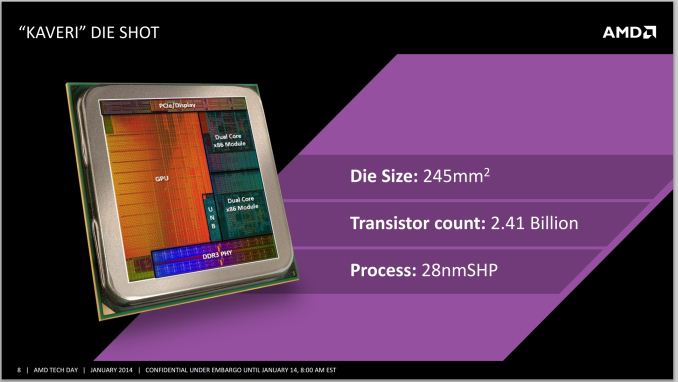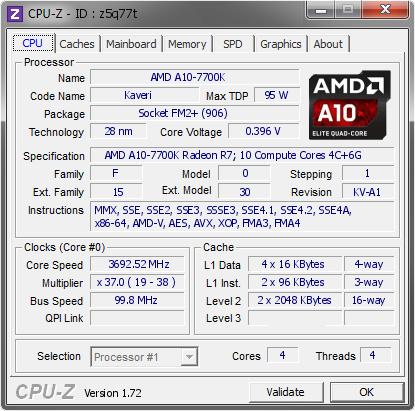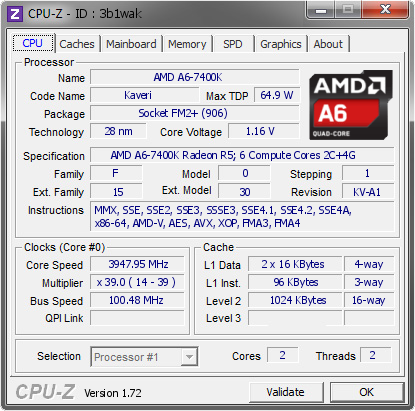The AMD A10-7700K and AMD A6-7400K CPU Mini-Review
by Ian Cutress on May 27, 2015 9:00 AM ESTAMD A10-7700K and AMD A6-7400K Conclusion
I started this mini-review stating that the question of the number of processors that both Intel and AMD produce all seem to differ by 100 MHz and $7, and that I had received questions as to why this is the case. Ultimately a lot of recommendations for computer components start to revolve around ‘Well for $10 more, you could get this’, and at some point you are considering something that costs $50 more. There has to be a point where you stop, especially if an IT department or system builder wants to go through and develop 200+ machines in a month.
Intel and AMD currently have different approaches to this. Intel likes to launch a big part of its stack all at once. Sometimes it will launch individual units outside this, or it will start a new line-up with one or two units then introduce the bulk later. With Haswell for example, on the socketed CPU space, we have 50 different CPUs varying in price, power, frequency, core count, threading and integrated graphics. Imagine the poor reviewer that has to test them all (insert here that I’d love to test them to get all the data, if I had time and could source them)!
AMD’s approach to Kaveri is to dribble rather than gush. Rather than overload the user base (both end-users and commercial) with a large haystack of parts, they launched two or three SKUs on day one, then one or two every 6-12 weeks since. This has some benefits, namely the improvement of the production process over time, the repeated opportunities to market new products and the opportunity to re-educate potential clients through the media. The downside of this strategy is one similar to starting with Swiss cheese and then filling in the holes – if a client wants a SKU with particular characteristics but the company does not have it, then they will go look for something else and take their money with them. It’s a method that acts as a double edged sword.
As AnandTech’s CPU editor, I get to play with a lot more SKUs than most. This means both the big shiny halo products, such as the 8-core goliaths, but also some of the higher volume dual core stuff which is more in line with a budget PC or mass PC build. With AMD’s strategy, as they have fewer processors overall, our coverage can be a little more complete than the others. AMD sampled us both the A10-7700K and the A6-7400K for this purpose, and we hope to work closely with them for future launches and get the best comparison list of their product stack.
Back to the SKUs tested for this mini-review, we can tell that the A10-7700K keeps up with the other A10 parts in our CPU testing, but as it has two fewer compute units in the integrated graphics it can lag behind a little and is more in line with the A8 processors in that regard, essentially making it more of a hybrid part. The A6-7400K fits into that budget CPU line at $64, and the results show this in both our CPU and GPU testing. The single module performs well enough in single threaded environments, but doesn’t have enough legs for the big tasks and can be swamped easily. Despite having two threads, the Bulldozer based design still has single-threaded like behavior in some tests. That being said, the graphics tests are a mixed bag. For titles that can use more threads, I can’t help but feel that it is a little held back, even at 256 SPs. For other titles, it performs on par with other processors almost double its price. Dual Graphics mode unfortunately was not possible with the A6, and it was also noticeable that some games (Shadows of Mordor in particular) took longer to load with only one module.
To say AMD’s APUs are like marmite (you either love them or hate them) is to gloss over a more complex issue. AMD’s design has its plus points and its negative points, a fact that AMD marketing knows when I speak to them. Nevertheless, they have to focus on the plus points, which include gaming at equivalent price points, DX12 support, OpenCL performance and moving forward with HSA. Using the right tool for the right job should now be considered a cliché, but it rings true when it comes to technology and more so than ever when innovative methods are continually being fashioned. Based on AMD’s Financial Analyst Day and their recent exposure into HBM (I highly suggest reading Ryan’s awesome writeup on it), I can safely say that I want to see an APU with HBM in the future. Despite the inevitability that AMD already know that people want one, I told them anyway. We will have to wait and see.














105 Comments
View All Comments
Flunk - Wednesday, May 27, 2015 - link
AMD's marketing department are a bunch of jerks. The A10-7700K has the iGPU from the A8 line! That's going s screw up a lot of people who don't know what they're buying. AMD could really benefit from clearer branding. Trying to be more obscure than Intel is not a good plan. This is the equivalent of Intel launching a new i5 chip with only 2 cores or an i7 without hyperthreading. The one thing that made buying the A10 worthwhile was that iGPU.
Based on the pricing and performance difference they could easily just have one of each category A10, A8, A6 and Athlon and not lose anything. AMD's marketing idiots are not their only problem but you can't beat the market leader if you under perform them at every step. Clearer marketing would be a real help.
jabber - Wednesday, May 27, 2015 - link
AMD and marketing go together like oil and water. They have always been hopelessly inept at it.Essence_of_War - Wednesday, May 27, 2015 - link
*raises hand*I was that guy.
I built my brother a mostly TF2 box to upgrade his ancient athlon desktop this past christmas, and I picked up an A10-7700k for him thinking it had the same igpu as the rest of the A10 line, not the A8 line. :/
WorldWithoutMadness - Wednesday, May 27, 2015 - link
Not your fault. Just blame those AMD guys.If you ever met with AMD employees, ask him whether he knows or if he is in charge on naming the product. Punch the guy who gave this atrocious naming
Alexvrb - Wednesday, May 27, 2015 - link
I always look at specs before I purchase something. Especially since, the part numbers are nearly useless by themselves. I don't care if it's AMD, Nvidia, Intel, Asus, G.Skill, or anyone else. If you get roped in by a product number, your geek card is suspended for a few months. :-PBeany2013 - Saturday, May 30, 2015 - link
Could be worse. I bought an A8 3870 APU. Then bought a motherboard without video output.I'm amazeballs, I am.
Still, for what I do, paired up with an R280 (was 7770) it's fine. I'm waiting for the Zen cores to come out before considering an upgrade, we'll see how they compare to whatever Intel is pushing at that point in terms of price/performance.
akamateau - Thursday, May 28, 2015 - link
If you upgrade to Windows 10 then your build will be pretty dam good. In fact it will be a far better gaming rig than ANY Intel i3, i5 or i7.nandnandnand - Thursday, May 28, 2015 - link
Did you get your M$ check?Alexvrb - Thursday, May 28, 2015 - link
They paid him the same amount they are going to charge him for a Windows 10 upgrade. He was also probably mentioning it because that chip will benefit greatly in the future from low-level APIs such as DX12. Good troll, I mean try, though.Edens_Remorse - Wednesday, May 27, 2015 - link
In so far as budget gaming is concerned AMD is not under-performing at all. The 860k(and 870k no doubt) is a far more intelligent choice than the similarly priced G3258. It's a shame this test was done the day before Godavari's launch. For those of us not red/green colorblind a review of the 7870k and 870k with their larger stock cpu coolers and improved IPC would have been very welcome.